TASKS: Here is a collaborative activity to do with your partners. Good luck!
http://www.boyle.kyschools.us/UserFiles/88/The%20Odyssey.pdf
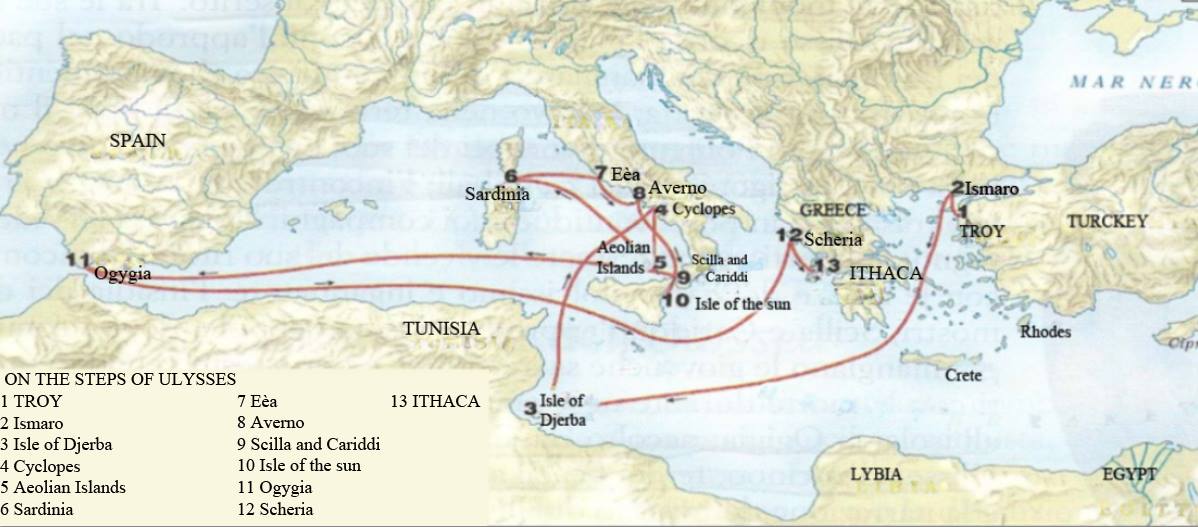
The theme of travel and traveler has always been at the center of literature, both classic and modern. Travel is one of the most present in the collective idealistic metaphors: life is understood as a "path" or a "pilgrimage", death as a "Transfer", the decisive moments of life as "rites of passage", as also safeness or asylum. The trip, a true “literary topos”, takes us through the centuries providing a concrete perception of the succession of civilizations, while retaining its primary meaning of conquest through the successful overcoming of the limits of the impossible.
The Odyssey is the epic poem that summarizes the concrete and symbolic meanings tied to the theme of travel. The journey of Ulysses is a return trip, from the Troian War to his native isle of Ithaca, the homeland left and found again with his wife Penelope and son Telemachus.
1) Ulysses leaves Troy, a city in Asia ,where he begins the famous “journey of Ulysses”, after the Troian War.
2) Odysseus and his men stop to Ismara, the capital of the Kingdom of Ciconi, in Thrace. Here they plunder the town and kidnap some of the clan's women. During a fight, however, women are able to run away and escape and Ulysses and lost several men.
3) Then Ulysses and his men move to the Isle of Jura in Africa where they find the lotus eaters. The inhabitants make some of Ulysses companions to eat a flower, also called the oblivion flower, and they seem to have found the happiness. Ulysses, however, manages to convince them to turn back.
4) Then they move to the Land of the Cyclops traditionally placed in Campania or Sicily (because of Vesuvius and Etna whose crater remembers the cyclops eye). Here Odysseus and his companions are trapped by Polyphemus, but thanks to the shrewdness of Ulysses, they escape
5) They move to Aeolo's isle, current Aeolians islands. Ulysses receves a gift from Aeolo a goatskin full of winds. Not knowing this, already arrived near the coast of Itaca, Ulysses opens the goatskin, thinking that inside it there was the gold, and so the winds push the boat away from there.
6) Then Ulysses and his men move to Sardinia, the Isle of Lestrigoni. The Lestrigoni are cannibals and they destroy all the ships of fleet, except for one, Ulysses' one, on which he's able to escape from that land.
7) Odysseus and his remaining companions lay over the island of Eèa where the sorceress Circe turn his companions into pigs. The hero saves them and remain on the isle for about a year.
8) Thanks to advice of the sorceress, Ulysses and the survivors can escape from the mermaids and their seductive but mortal song.
9) Once arrived in the Strait of Messina, they meet the two sea monsters: Scylla and Charybdis, a monster with six heads and a terrible whirlpool.
10) Then they move to the Isle of the sun, in Sicily. Here they graze the sacred oxen of the Sun God but Ulysses' companions eat them, despite theese are sacred animal; so the Sun God unleashes a storm where all lost their lives, except Ulysses.11) Ulysses moves to the isle of Ogygia. There are several opinions for the placement of Ogygia in real geography: just outside the Strait of Gibraltar or, according to local traditions of Dalmatia, the island of Mljet; according to other authors is the island of Gozo in the Maltese archipelag, where you can visit the cave "Calypso" ; but still, the island of Gavdos in the south of Greece. According to some recent studies, Ogygia would be facing the Calabrian coast of the Ionian Sea, for still others it would be the island of Pantelleria. Here lives the nymph Calypso where Ulysses remains for seven years. When Ulysses wants to leave the isle, the nymph, in love with him, offers him immortality, but the hero refuse it and leave again to Ithaca.
12) The traditional narratives outline the Feaci as people who live in a "locus amoenus"(an utopian ideal perfect place), in terms of happiness and prosperity, which remark the harder living conditions faced by the Greeks. Unclear is the location that the tradition assigns to this people, but probably is the Greek Island of Corfù. Nausicaa, the Island Princess, is the first to chance upon the hero returning the shipwreck and to offer hospitality. Ulysses then, during the dinner, tells Alcinous, the king of the island, its adventures. Alcinoo decides to help him to return home offering him a ship.
13) Finally arrive at home, to Ithaca, Ulysses finds his palace invaded by the Proci who want to marry Penelope and sit on his place on the throne . After a violent clash, Ulysses is able to banish them and to return to his wife and his son Telemachus.
Feliciotti Margherita
#TASK 2: EACH GROUP FINDS AND POSTS BELOW ANY IMAGES OR MAPS OF THE NEW REFUGEES ROUTES WE CAN COMPARE /OR NOT/ TO ODYSSEUS JOURNEY. GOOD LUCK!

New refugees don't only travel across the Mediterranean Sea. They go through the continents of Africa and Europe. They travel into rich countries like Germany, Sweden or Norway.
Filip Kwiatkowski
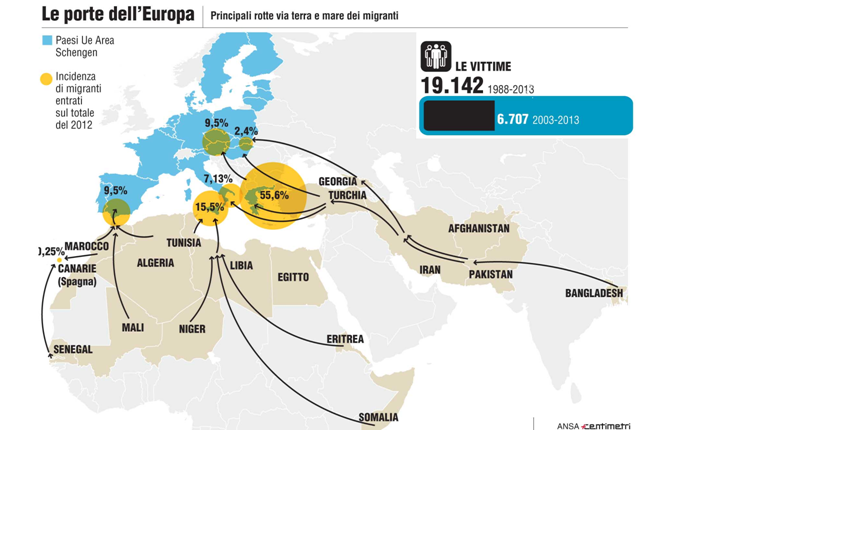
This picture represents the main migrants’ routes by land and by see. Wee can understand that between the 1988 and the 2013 there were 19142 victims and this number in these last three years it’s increased so much. Wee can see that the favourites destinations of these migrants is the europe and they arrive very often to Spain, Italy and Greece. All the states are trying to help migrants but often they leave alone those poor persons not because they don’t mind but because they already have a lot of interior problems that are very difficult to solve amd that prevent a state to help them.
I think wee can compare all these routes with Odysseus’ juorney beacause even the Homeric hero have done a very long travel often landing in places unknown to him as a migrant and he was not always accepted kindly.
ALESSIO PESCIAIOLI
MIGRANTS ROUTE IN ITALY IN THE LAST TWO YEARS:
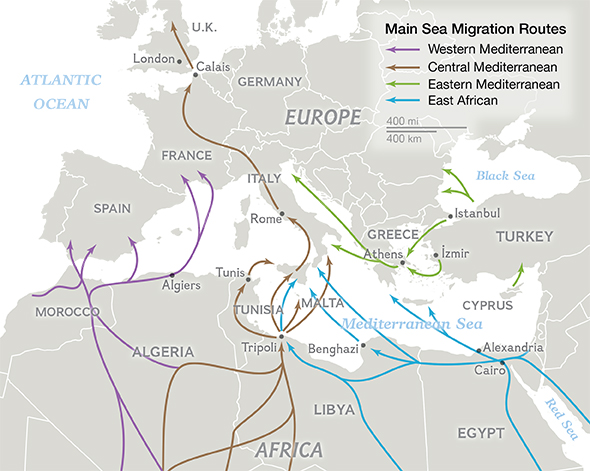
In 2014 they landed on Italian shores 170,100 refugees and migrants (out of a total of 220,194 who have arrived illegally in the European Union through the Mediterranean in 2014) , an increase of 296% compared to 2013 (42,925 landed ) and even the previous peak of 2011 (62.292 landed) . 141,484 of landed in Italy in 2014 had left the coast of Libya, 15,283 from the coast of Egypt and 10,340 from the coast of Turkey. The main countries of citizenship of landed were Syria (42,323), Eritrea (34 329), Mali (9908), Nigeria (9000), Gambia (8691), Somalia (5756) and Egypt (4095). The increase in the landings is due both to the largest number of refugees coming from Syria in particular because of the Syrian civil war, to the greater ease and urgency to start from the Libyan coast because of anarchic situation created by civil war in Libya . Many of the landed were seeking asylum, especially Syrians and Eritreans, whose asylum applications in Europe in 2014 are examined were accepted positively by 95% and 89% of cases, respectively .However, only very few Syrians and Eritreans have applied for asylum in Italy (500 and 480, respectively) , while most continued to northern Europe (Germany and Sweden in particular) despite the Dublin Regulation provides that for asylum have to claim asylum in the first country of arrival . In 2015, refugees and migrants landed in Italy were 153,842, 9% less than in 2014. Unless a drastic reduction in the number of Syrian refugees, moved on route from Turkey to the coasts of Greece (where in 2015 landed 856,723 refugees and migrants in the context of the European refugee crisis), the main nationalities declared upon landing were Eritrea (38,612), Nigeria (21,886), Somalia (12,176), Sudan (8909), Gambia (8123), Syria (7444) and Mali (5752).
ANNA LA MICELA
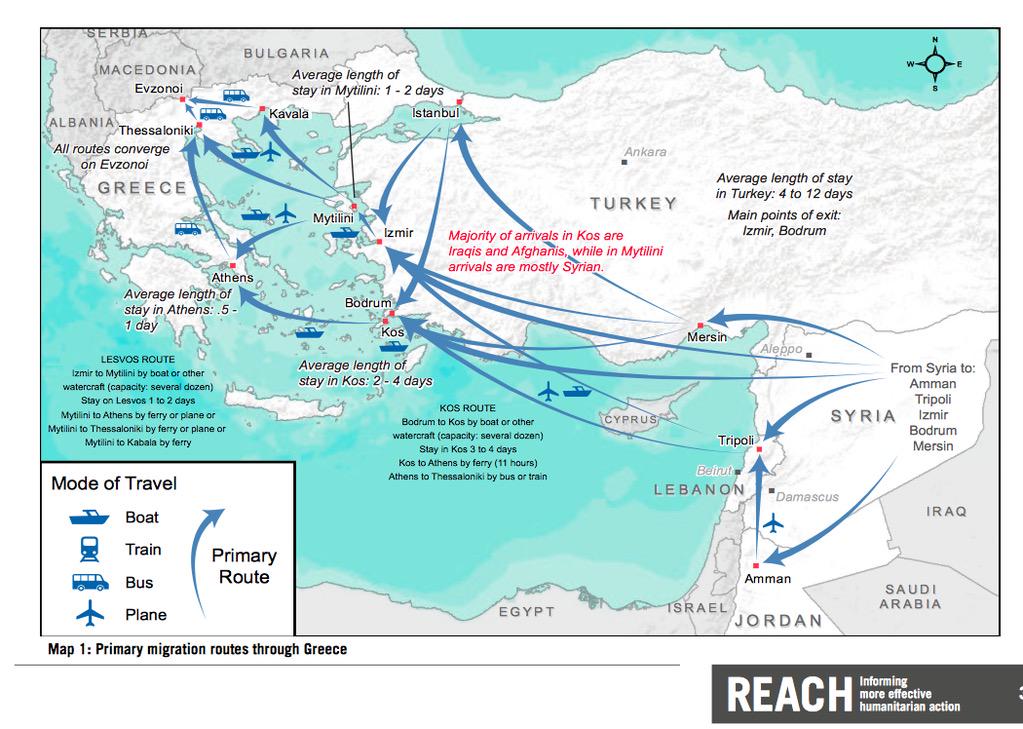
I saw that many of the maps posted descrbed the situatuion near Italy or in general , so I want to show us the situation of primary migration routes throught greece as of september '15 to have another point of view ! The data are explain very well on the map! I hope it can be usefull !
ELEONORA CATARINELLI
Mervet Chaktmi (Tunisia)
Civil unrest in Syria has sparked the biggest global displacement crisis in over two decades and a heated debate among European leaders over how many of the thousands of refugees to take in.
German Chancellor Angela Merkel has championed quota system for EU countries rehoming refugees while Britain has resisted taking any more than 20,000 Syrian refugees over five years.
As the politicians squabble it's worth keeping in mind the huge distances migrants travel to get to Europe through Africa and the Middle East, along well-worn routes.
These graphics from Reuters put that in perspective. They also show how central Turkey and Greece are to the migrants' routes (green lines). The countries act like bottlenecks.
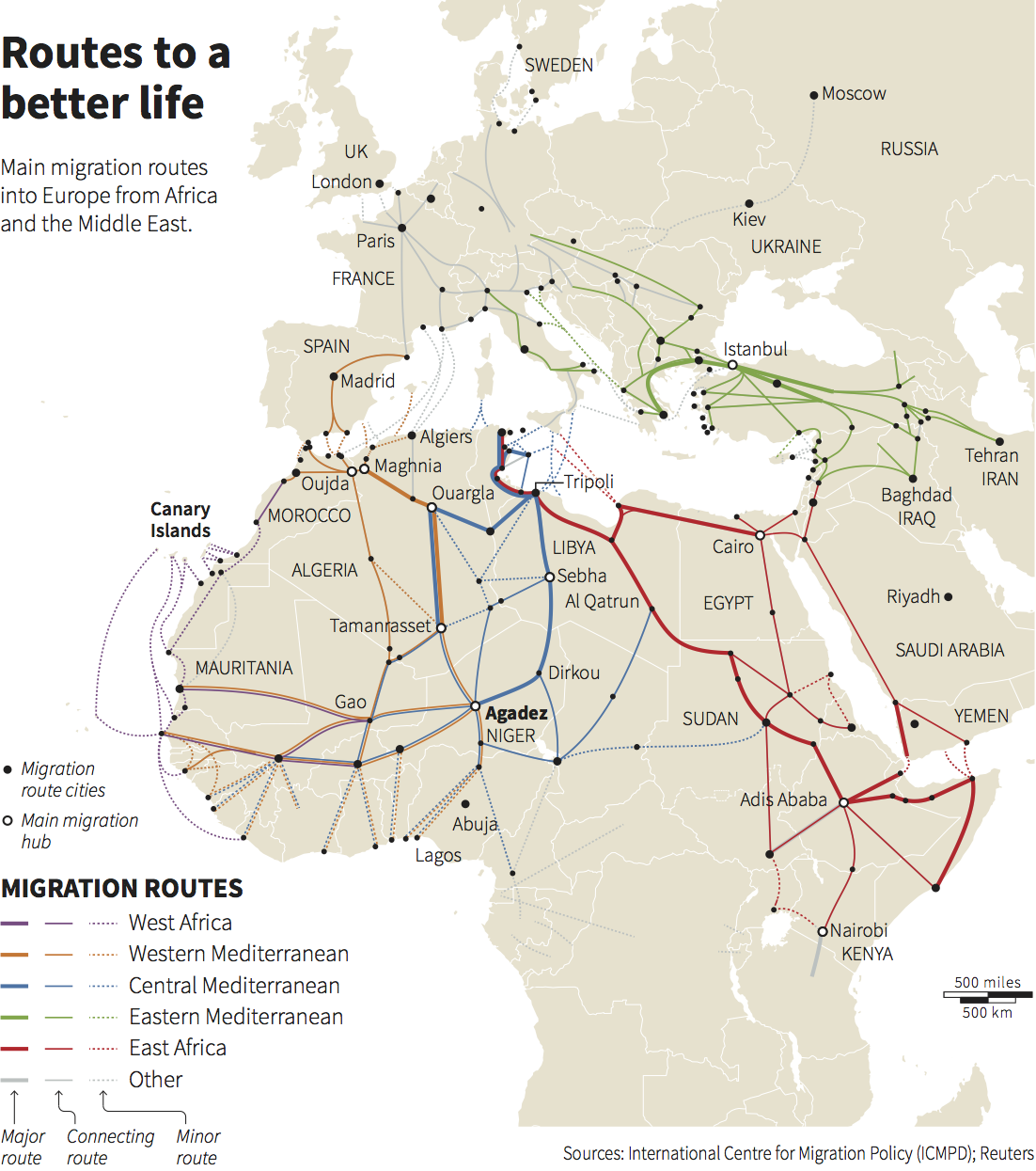
Once they get to the shore of the Mediterranean, the journey gets even more dangerous and deadly. Last year more than 3,000 migrants died trying to cross.
The migrants aim for the mainland mostly, hitting Spain, France and Italy but avoiding Sardinia, right in the middle of the sea.
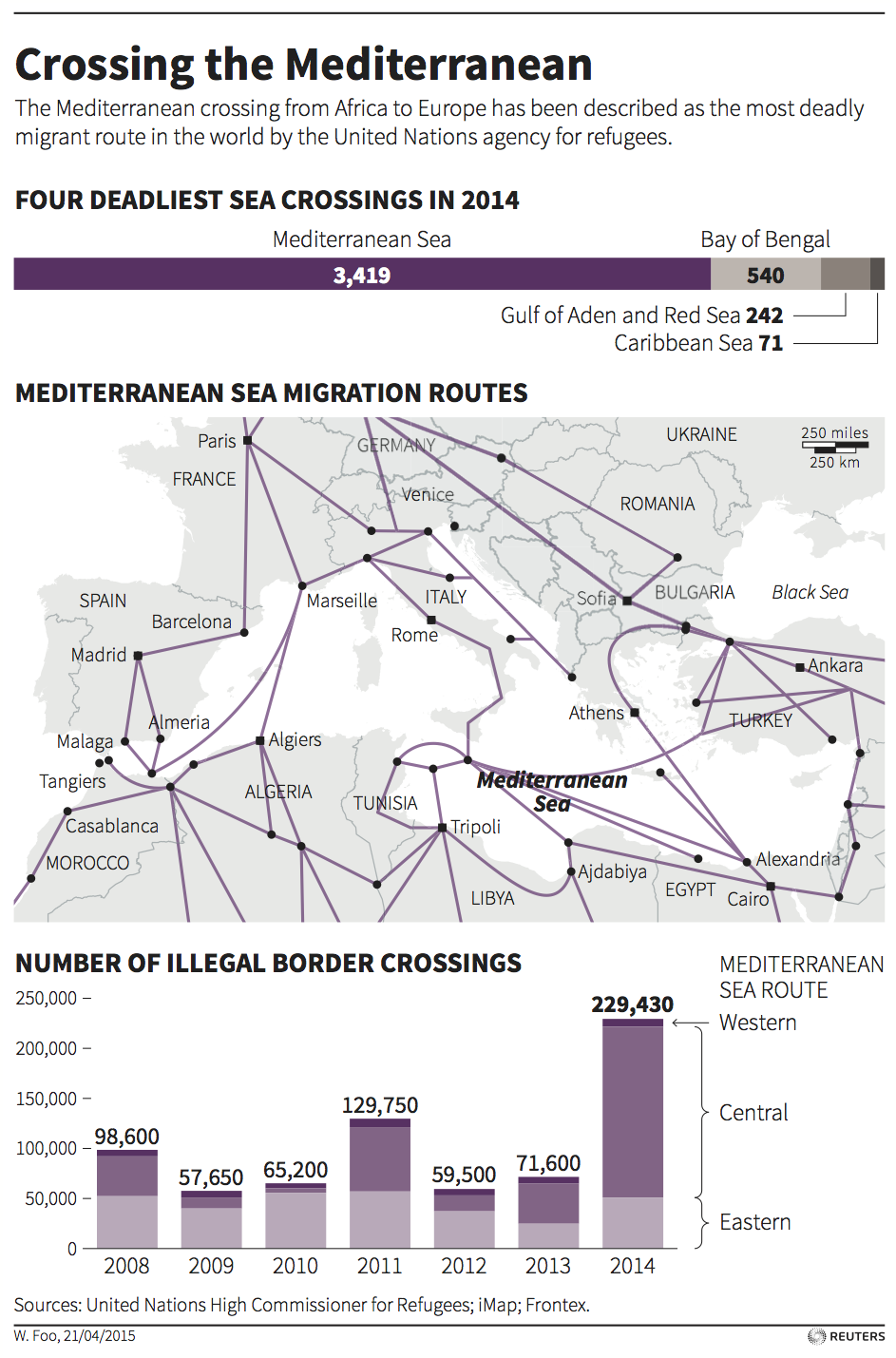
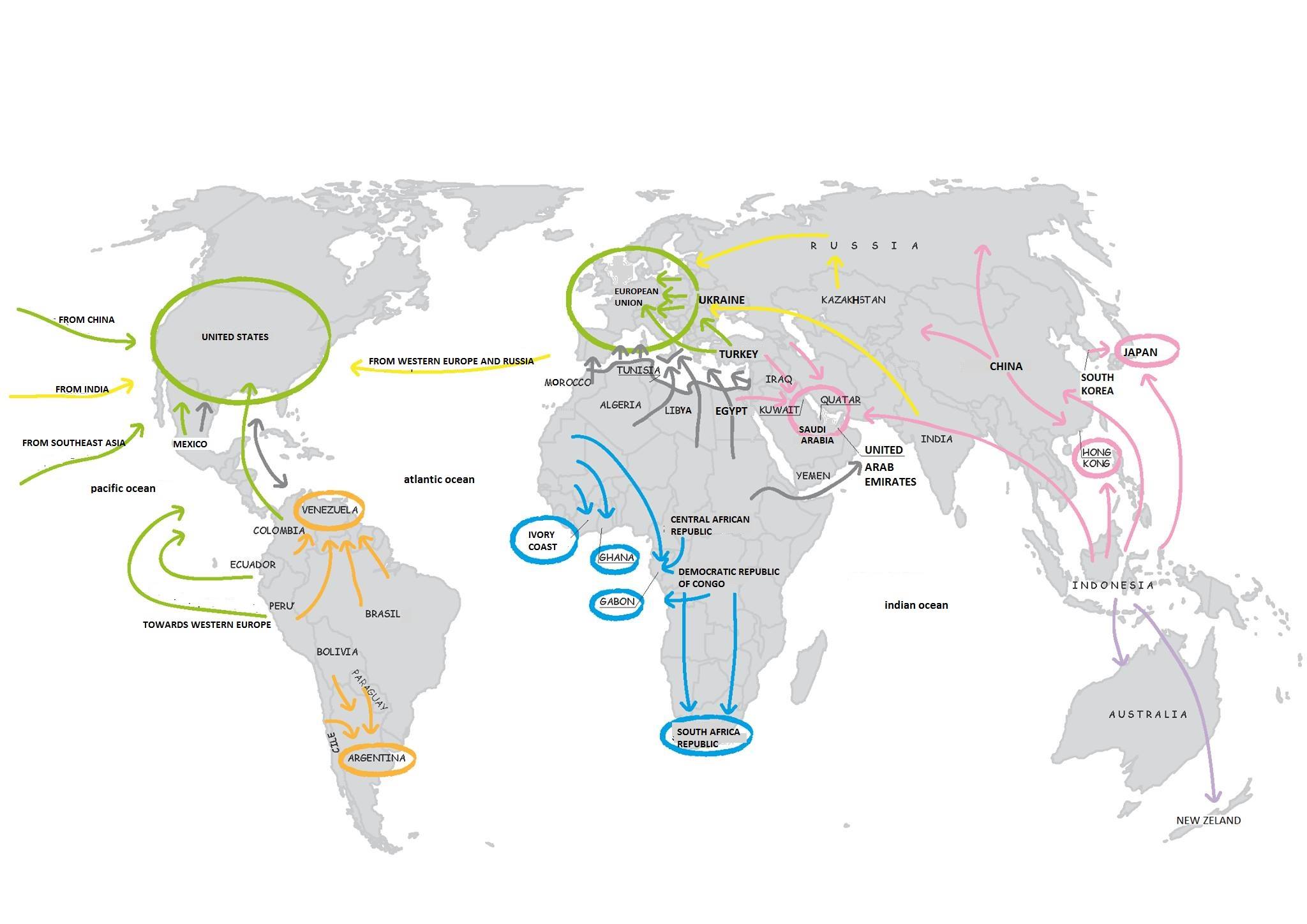
Umanity in moviment:migrants,refugees,fugitive on XIX century
ELISA MAGGI